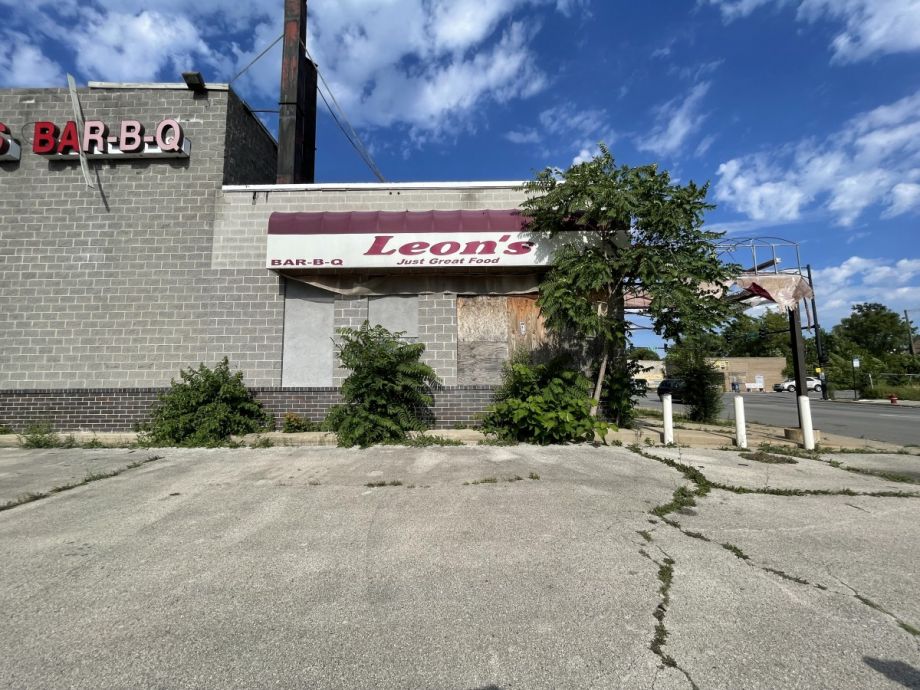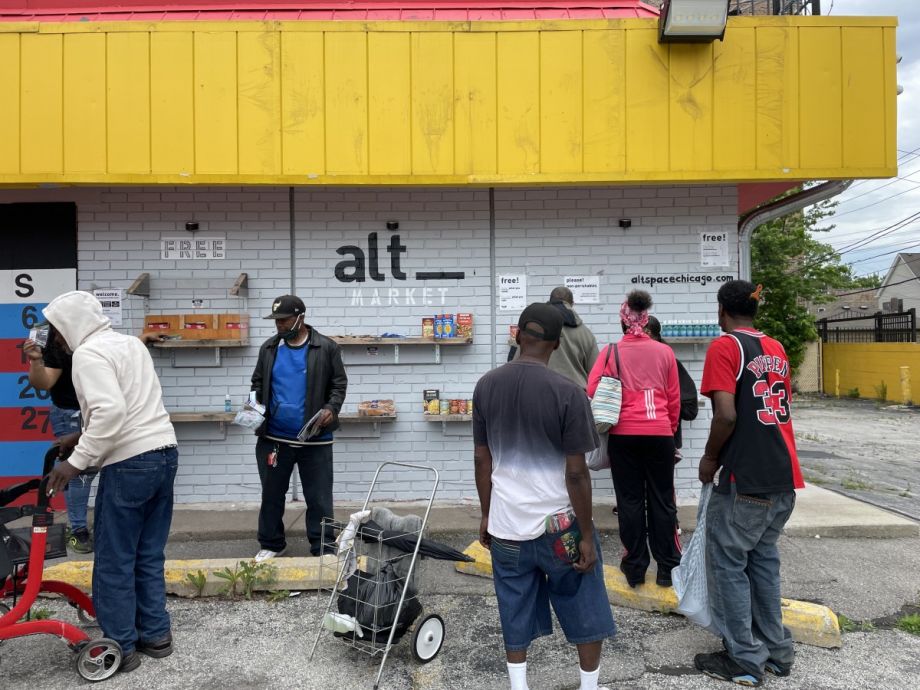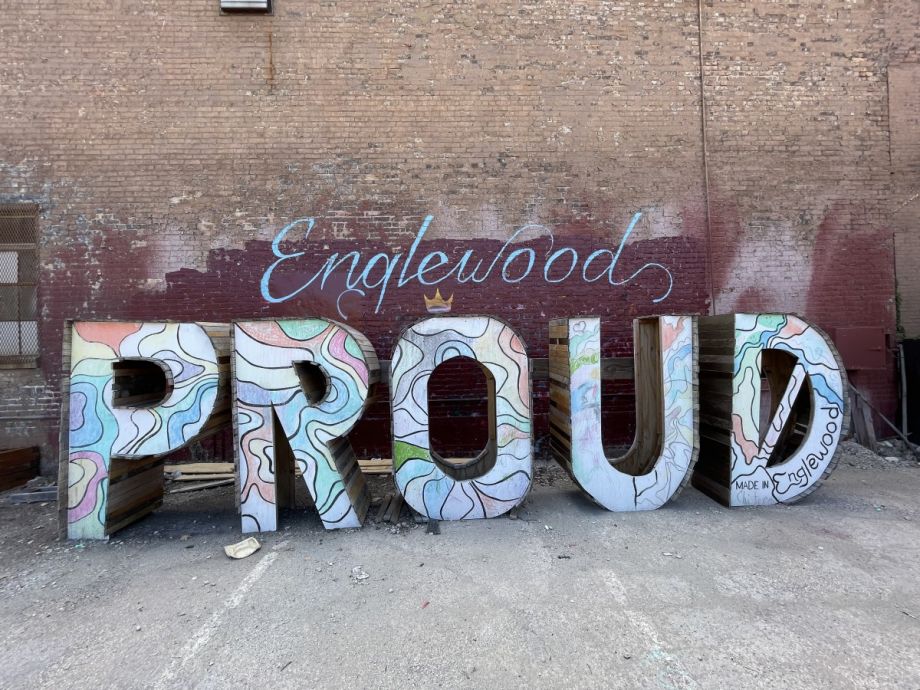Driving down 59th Street on the South Side of Chicago, Asiaha Butler points out one property after another. Some are boarded up, some are churches, some are liquor stores. But one of them is going to be the one where she believes a new chapter in the economic history of Englewood will begin — a chapter written by its residents.
Butler is president of the Residents Association of Greater Englewood, or RAGE, which she co-founded with a dozen of her neighbors in 2010. They regularly hold meetings and other events in the community. At their Annual Membership Meeting in December 2019, they filled a college auditorium with folks who live or work in the neighborhood, who spent most of the day talking about the common challenges they face and strategizing around how to address them together.
In response to the pandemic, the association collaborated with local artists and others to create the Englewood Alt_ Market, a sort of mutual aid goods and resources exchange that takes place on Wednesday afternoons. During last year’s civil unrest in the wake of George Floyd, Breonna Taylor and other Black people being killed or shot by police around the country, RAGE found themselves fielding calls from people looking for Black-owned businesses to support in Englewood, a neighborhood of nearly 23,000, 95% of whom are Black.
“We reached out to the Greater Englewood Chamber of Commerce, to the aldermen, and we asked if there is a Black-owned business list or directory that we could see if they need some support, and unfortunately that did not exist,” Butler says.
So they created one. Including West Englewood, they found 33 Black-owned businesses across the combined area with around 57,000 nearly all Black residents. That ratio of businesses to potential customers did not sit well with Butler. Although the median income of the neighborhood is only around $23,000, collectively Englewood households earn around $300 million, but according to one older study some 70 percent of those earnings get spent outside the neighborhood.
“We had to jump in and do something to help change the landscape,” Butler says. “Because that [lack of economic engagement] kind of pulls back the curtain as to why there is so much shooting, why there is so much disinvestment, and looking at the system that has allowed this to be the landscape for a community like Englewood.”
Out of that came a plan to rehab commercial spaces in the neighborhood and lease them to Black-owned businesses. The businesses will get a deep discount on rent in exchange for hiring from the neighborhood, which had 25% unemployment before the pandemic. RAGE has raised enough money so far, from one anonymous donor, to acquire and rehab two or maybe three small commercial properties, Butler says. They plan to raise more.
One RAGE member who happens to be a real estate agent stepped up to volunteer to investigate properties and do initial outreach to owners. But so far, they’ve been running into a lot of frustrating dead ends — even though there are properties that clearly have owners who don’t seem to be interested enough in those properties to keep them in relatively good condition, even if there is an active tenant there.
“As we’ve found out, the owners don’t live in Englewood, don’t live in Chicago mostly,” Butler says. “The majority of the people holding our corridor buildings that we reached out to try to buy those buildings, either they’re not interested in selling, they’re trying to hold them or they’re just unavailable to reach.”
Finally, at the end of July, RAGE entered into the process to acquire its first property from the Cook County Land Bank Authority, which exists to get vacant land or abandoned buildings back into use. It’s a 14,000 square foot, two-story structure that once housed a barbeque and pizza carry-out. The group plans to reactivate it as a food business and perhaps event space on the first floor and a new RAGE headquarters on the second floor. And they hope it will be the first of many small commercial properties they’ll acquire along 59th Street, from the land bank or off the private market.
“Before the powers that be work their magic to gentrify this area, RAGE definitely wants to disrupt that typical pathway for urban communities,” Butler says. “We’re trying to disrupt that in every way we can and if we could have ownership over a corridor or areas of Englewood, we feel like we’ve done our part. We’ll have more control over what happens to these assets.”

The building that RAGE is in the process of acquiring (Photo by Oscar Perry Abello)
It can be challenging to acquire and revitalize commercial properties in any predominantly Black, largely disinvested community. Just getting the capital to do so can be an impossible barrier.
Even if a small, local developer from that community has a good relationship with a lender, most lenders make loans based on market value of the property, and they usually determine market value by looking at “comps,” i.e. recent sales of comparable properties nearby. For disinvested neighborhoods like Englewood, sometimes there are periods when there just aren’t many sales of anything commercial or residential. For commercial properties particularly, in places like Englewood, there might not have been any sales for years, even decades along some corridors. So the banks don’t have any comps to use for the purpose of underwriting a loan.
At Chicago Community Loan Fund, a lender that specializes in lending for projects in disinvested communities across the Chicago area, Vice President for Economic Development Maurice Williams says he would need to see at least one nearby sale a month for several months in a row to really feel confident about using comps to determine the size of a loan. There aren’t many corridors on the South Side or West Side of Chicago where Williams is seeing even that meager level of activity.
Even if you or the lender can get an appraiser to come up with a market value, it’s very likely that appraiser won’t value that property at a price that allows for a large enough loan to buy the property and rehab it. Chicago is an unfortunate poster child for the phenomenon of appraisers undervaluing properties simply because they’re in a Black neighborhood or because they’re owned by a Black person. Not to mention, given the state many of these buildings are in, they need a lot of rehab work and determining how much they need is itself a whole other barrier.
There are ways for community development lenders to make loans without relying on appraisals or comps, but they generally rely on having established revenue streams from reliable sources such as government contracts for providing social services. There’s the federal New Markets Tax Credit program, but it requires such onerous paperwork that it’s mostly used for projects around $20 million or more.
There’s also the Small Business Administration’s 504 loan guarantee program, which is supposed to support more loans to small businesses to buy, build or renovate buildings, by reducing risk for private lenders to make loans. But out of 7,119 loans that the 504 program guaranteed in the agency’s Fiscal Year 2020, just 128 went to Black-owned businesses, according to SBA data.
Thanks to its anonymous donor, RAGE doesn’t face any of those barriers, at least for its first few properties. What it faces instead is Chicago’s peculiar landscape for revitalizing vacant or abandoned properties, which is heavily tilted against smaller, community-based developers. They are hardly the first to make inquiries about certain properties that might appear to be available for sale, only to find cold rebuffs or no response at all from absentee landlords.
“Absentee landlords and ownership is still a major challenge within major urban markets like Chicagoland,” says Williams.
Besides, the deedholder may no longer be the one who really has control of the property or any interest in the property — that responsibility may lie with a bank who has a lien on that property related to a defaulted loan.
“That’s when it’s most difficult,” Williams says, “because if it’s foreclosed or in receivership or just walked away on, it’s hard to know where or who holds title, whether it’s a national or local lender.”

People visiting the Alt__Market in Englewood (Photo by Oscar Perry Abello)
And that’s not even the worst case scenario in Chicago. Cook County, which surrounds and encompasses Chicago, has a unique and 80-year old system to manage severely delinquent property taxes and other public debts that may be attached to properties. It’s called the scavenger sale.
The Center for Municipal Finance at the University of Chicago recently published the first in-depth evaluation of the scavenger sale, analyzing data going back to 2007.
“This system is pretty big, touches a lot of properties, but no one had any idea how it worked or if it worked,” says Maxwell Schmidt, principal researcher and author of the study. “No one had ever really looked at this thing that’s been around 80 years and deals with tens of thousands of properties.”
The path for properties into the scavenger sale typically starts with delinquent property taxes. Like other counties or municipal governments, Chicago conducts an annual tax lien sale, where buyers pay the amount a property owes for the right to collect that amount plus interest from the property owner.
Chicago does the kind of tax lien sale where the winning bids are the ones who offer to charge the lowest interest rate to the underlying property owner. Most owners end up paying, but if they don’t, the lien buyer has the right to foreclose and take ownership of the property — a process that takes two and a half years at the minimum for residential properties, per state constitution. But if a property in Cook County has tax liens that go unsold in at least three consecutive years, then it gets moved into the scavenger sale.
In the scavenger sale, the right to collect on the taxes owed gets sold to the highest bidder, and the minimum bid is just $250. The scavenger sale happens only in odd-numbered years. Similarly, if the underlying owner doesn’t pay, the scavenger sale buyer has the right to foreclose and take ownership of the property free and clear of the previous tax debt.
So the scavenger sale gives potential buyers a chance to acquire properties for as little as $250, no matter how much in property taxes the previous owner might have owed. But going through the foreclosure process itself is onerous.
“The process is bananas,” says Cook County Commissioner Bridget Gainer, who also chairs the board of the Cook County Land Bank Authority. “It takes about four years, and 75 distinct steps to go through if you want to take ownership of a property out of the scavenger sale.”
The past few scavenger sales have averaged around 30,000 properties, most of them residential, but they have included three to four thousand commercial properties, which is not an insignificant amount even for Chicago. And scavenger sale properties have been concentrated in predominantly Black parts of Cook County, including Greater Englewood and other parts of the South and West Sides of Chicago.
“We’ve tolerated things happening to Black neighborhoods that we would never allow to happen to white neighborhoods,” says Gainer.
According to the Center for Municipal Finance’s analysis of scavenger sale data provided by the Cook County Treasurer’s Office, most scavenger sale properties never even get bids. The majority of the purchasers are out-of-state banks or hedge funds, and the majority of the purchases just end up going back into the next scavenger sale.
“The people who are making the majority of scavenger sale purchases, they’re buying dozens at a time, and majority of those buyers are out of state financial entities like banks or hedge funds, so not even large scale developers,” says Schmidt. “It makes some sense, because we’re not talking about neighborhoods that are ideal for large profit-driven developers.”
Even the banks and hedge funds often decide it’s just not worth going through the foreclosure process if they’re not sure the property is worth it.
“[The banks and hedge funds] have two years to figure out if they can sell it, and they’re really only interested in properties where they can make a killing,” says Gainer.
The Center for Municipal Finance also gathered opinions on a sample of scavenger sale properties from developers, both large and small, including some who live in areas where there are a lot of scavenger sale properties. The center wanted to get a sense of whether, aside from the onerous process, were any of these properties attractive to any developers. Larger developers didn’t show much interest, but smaller mom-and-pop developers did see some potential in some properties, including commercial properties.
The Cook County Land Bank Authority has a special power in the scavenger sale. As a county agency, the land bank can submit what’s called a “no cash bid,” for the exact amount of debt attached to each property. If no one outbids it, rather than actually paying that amount, the land bank wins the scavenger sale for that property and it extinguishes the debt attached to it before reselling it, free and clear of the previous debt — but only after going through that same onerous, multi-year foreclosure process.
The Cook County Land Bank Authority was created in 2013, and the first scavenger sale it participated in was 2015, and since that year it has used no-cash bids on an average of more than 9,000 properties in each of the three scavenger sales it’s participated in so far. Still, the onerous foreclosure process and other hiccups have meant the land bank has also returned the vast majority of those properties into subsequent scavenger sales.
Overall, in the Center for Municipal Finance’s analysis, 94 percent of scavenger sale properties end up back in the following scavenger sale, same before and after the land bank was created.
Butler still sees the land bank as a valuable partner to her group’s efforts going forward. RAGE’s first property came through the land bank, and there is already at least one more in the land bank’s portfolio that is on its radar. The land bank is also aware that RAGE is interested in the 59th Street corridor in particular, and there is another scavenger sale coming up this fall that may lead to more acquisitions based on where the land bank knows there is local interest in revitalizing vacant or abandoned properties.
Though its capacity has been limited up to this point, the land bank exists in large part to take on those headaches so that smaller, community-based developers like RAGE don’t have to shoulder that burden. They can simply go to the land bank and apply for properties once they’ve come out of that maze of courts and documents.
Gainer, meanwhile, is sorting through various state or local legislative changes that could make things go more smoothly for the land bank’s acquisition process. to get through the foreclosure process or open up more channels for the land bank to acquire distressed properties and use its powers to extinguish delinquent property tax debt.
Since inception, the land bank has taken more than 2,300 properties into its ownership, while it has sold more than 1,100 properties to developers. The vast majority of those properties have been residential — around 6% of the land bank’s current inventory are commercial buildings. Nearly three-quarters of the land bank’s inventory are vacant parcels.
According to former executive director Robert Rose, who stepped down from the position at the end of June, of the more than 650 developers that Cook County Land Bank Authority has sold its inventory to so far, most have been on the smaller side, 50% are Black and 20% are Latino — reflecting largely the demographics of Chicago’s most disinvested communities on the South and West Sides.
In more recent scavenger sales, the Cook County Land Bank Authority has strategically started placing more no cash bids on commercial properties — partly in response to interest from groups like RAGE, who see the connection between the Black homeownership they want to create and the businesses that those prospective homeowners want to see along the commercial corridors.
Decades ago, before disinvestment set in, corridors like 59th Street or 63rd Street in Englewood were once thriving commercial corridors, first Italian or Polish, then Black. Then the city stopped investing in schools and parks and transit and neighborhoods started slowly disintegrating into what can be seen today. Larger redevelopment projects like the Englewood Square shopping center featuring a Whole Foods, at 63rd Street & Halsted Avenue, sit along stretches of smaller properties, many of them boarded up or completely vacant.
“You need them together,” Butler says. “You definitely can’t do a business corridor without people, and you definitely can’t build houses without businesses. Hopefully in the next five years this whole entire neighborhood and all its corridors really comes together, with the city putting in its investments, too. But it starts with one.”
EDITOR’S NOTE: We’ve updated the language in this story to reflect the current status of the first building RAGE is in the process of acquiring through the Cook County Land Bank Authority.
This article is part of The Bottom Line, a series exploring scalable solutions for problems related to affordability, inclusive economic growth and access to capital. Click here to subscribe to our Bottom Line newsletter.

Oscar is Next City's senior economic justice correspondent. He previously served as Next City’s editor from 2018-2019, and was a Next City Equitable Cities Fellow from 2015-2016. Since 2011, Oscar has covered community development finance, community banking, impact investing, economic development, housing and more for media outlets such as Shelterforce, B Magazine, Impact Alpha and Fast Company.
Follow Oscar .(JavaScript must be enabled to view this email address)


















